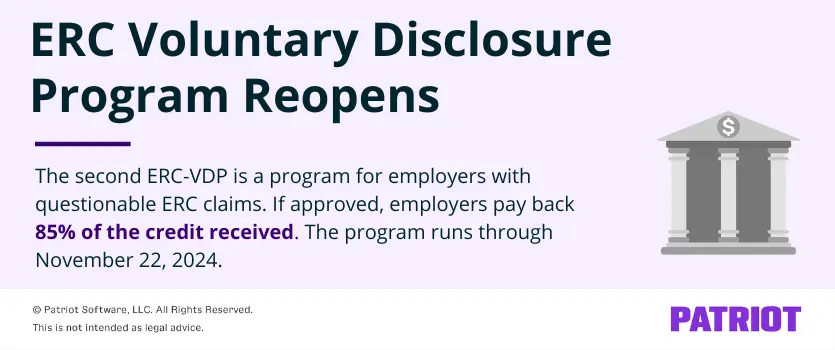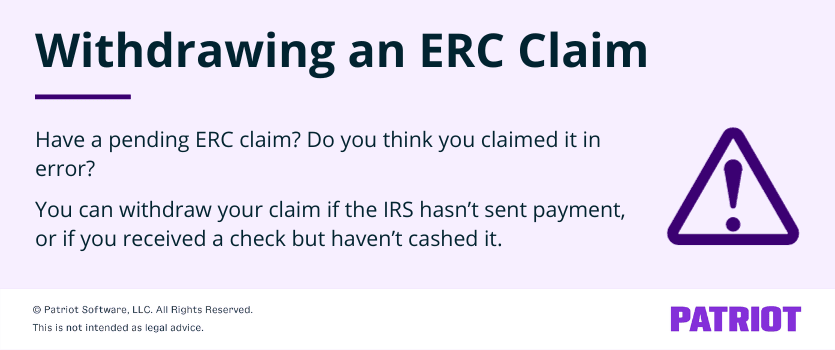The employee retention credit (ERC) was a lifeline for small businesses struggling to stay open during the pandemic. But bad actors quickly pounced on the opportunity. “ERC mills” began aggressive marketing campaigns advising employers to apply (even if they didn’t qualify) and collecting hefty upfront fees.
As a result, a slew of unqualified applications flooded the IRS. In response, the IRS has sent 28,000 disallowance letters to employers who incorrectly claimed the ERC. And on December 21, 2023, the IRS unveiled a new program: The ERC Voluntary Disclosure Program (ERC-VDP).
Through the ERC-VDP, employers who claimed and received the credit in error can pay it back at a discounted rate. The original ERC-VDP ran through March 22, 2024. But on August 15, 2024, the IRS announced it would be reopening the program through November 22, 2024.
Here’s everything you need to know about the second ERC-VDP.
Employee retention credit terms [cheatsheet]
Here’s a quick reference guide to the employee retention credit, disallowance letters, the ERC-VDP, and ERC claim withdrawals:
| Term | Definition |
|---|---|
| Employee Retention Credit | Fully refundable tax credit eligible employers who kept employees on payroll during the COVID-19 pandemic could claim. Credit is available on qualifying employee wages paid between March 13, 2020 and December 31, 2021. |
| ERC Disallowance Letters | Letter 105C, Claim Disallowed, from the IRS notifies employers that they do not qualify for the employee retention credit and must return the money they claimed and received. |
| ERC Voluntary Disclosure Program | IRS program that lets employers who received the ERC in error repay 80% of the claim received. The program ran from December 21, 2023 – March 22, 2024. |
| Second ERC Voluntary Disclosure Program | IRS program that lets employers who received the ERC for 2021 tax periods in error repay 85% of the claim received. The program runs through November 22, 2024. |
| Withdraw an ERC Claim | Employers who filed a claim but haven’t yet received the refund for the ERC can withdraw their claim. |
Employee retention credit overview
The employee retention credit is a fully refundable coronavirus payroll tax credit for employers who kept employees on payroll during the pandemic. The ERC was first established under the CARES Act and later expanded under the Consolidated Appropriations Act and the American Rescue Plan Act.
Small employers had to meet rigorous requirements to qualify for the employee retention credit. Employers could then apply for the credit on federal employment tax returns (e.g., Form 941). Employers may have until 2025 to claim the employee retention credit retroactively.
For small business owners, the ERC provided a way to keep their companies operating and employees paid during a difficult time. Unfortunately, the IRS noticed an uptick in aggressive marketing surrounding the ERC.
ERC mills and aggressive promotion
The IRS is working on hundreds of criminal cases and referring thousands of ERC claims for audit. The ERC mills’ aggressive marketing targeted many unqualified businesses.
According to the IRS, warning signs of aggressive ERC marketing include:
- Unsolicited calls or ads that say it’s an “easy application process”
- Statements that the ERC promoter can determine eligibility in minutes
- Large upfront fees or fees based on a percentage of the refund amount
- The preparer’s refusal to provide their identifying information or sign the ERC return
- Overpromising that the business qualifies for the credit before discussing the company’s tax situation
Sound familiar? If your business trusted an ERC promoter, the IRS offers a chance to come clean through the Voluntary Disclosure Program. Because many ERC promoters charged a percentage fee, the IRS is reducing the payback amount.
A word of advice: Work with a trusted tax professional for help claiming credits. A tax professional can work with you to understand your company’s situation and determine eligibility.. A tax professional can work with you to understand your company’s situation and determine eligibility.
What is the ERC Voluntary Disclosure Program?
Businesses that erroneously receive the ERC must pay it back, possibly with significant penalties and interest. However, the ERC-VDP lets companies pay it back at a discounted rate—with no penalties and interest. And, the IRS will not charge civil penalties for underpaying employment tax attributable to the ERC.
The original ERC-VDP ran from December 21, 2023 – March 22, 2024 and offered a 20% discount. Businesses that applied during this time only paid back 80% of the credit received. During this time, 2,600 businesses applied and disclosed $1.09 billion worth of credits.
On August 15, 2024, the IRS reopened the program through November 22, 2024 for ERC claims made for tax periods in 2021. Like the first program, the second ERC-VDP offers a discount. However, the discount has been reduced to 15%. Businesses that apply before November 22 only pay back 85% of the credit received.

IRS Commissioner Danny Werfel urges employers with questionable ERC claims to take advantage of the ERC-VDP, saying:
The limited reopening of the Voluntary Disclosure Program provides an opportunity for those with improper claims to come in ahead of IRS compliance work and get a discount on repayments … This provides a final window of opportunity for those misled businesses to make adjustments and avoid future compliance action by the IRS.”
The IRS will reclaim the full amount through regular tax assessment and collection processes if you don’t apply for the program and the IRS flags you for receiving an excessive or erroneous credit. Currently, the IRS is auditing thousands of ERC claims.
To participate in the ERC-VDP, you must provide the IRS with the names, addresses, and phone numbers of any advisors or tax preparers who advised or assisted you with your claim, along with details about their services.
Who can apply to the ERC-VDP?
You may qualify for the second ERC-VDP for each tax period in 2021 that you claimed the ERC on an employment tax return and now believe you were entitled to a $0 credit. To qualify, the IRS must have processed the claim and paid out the credit as a refund or applied it to the tax period or another tax period.
However, not all businesses are eligible for the IRS Voluntary Disclosure Program. You are ineligible if you are under an IRS audit or criminal investigation. You are also ineligible if the IRS reversed or notified you that your claim is invalid (e.g., if you received a disallowance letter).
Businesses that used a third-party payer to file employment tax returns or claim the ERC must contact the third party to apply for the ERC-VDP.
How to apply to the second ERC-VDP
To apply to the second Employee Retention Credit Voluntary Disclosure Program, you must:
- Fill out Form 15434, Application for Employee Retention Credit Voluntary Disclosure Program
- Fill out ERC-VDP Form SS-10 (included within Form 15434)
- Have an authorized person sign your form(s)
- Follow the IRS instructions to submit your application online using the IRS Document Upload Tool by 11:59 p.m. (local time) on November 22, 2024
What to do if you can’t pay back 85% of the credit right away
Can’t pay the full 85% of the credit you received right away? You can ask the IRS to set up an installment agreement. Keep in mind that installment agreements are subject to penalties and interest.
To request an installment agreement, submit Form 433-B, Collection Information Statement for Businesses, along with required supporting documentation. Form 433-B asks for information about your company’s financials, such as assets and liabilities.
The IRS will consider installment agreement requests on a case-by-case basis.
You must also sign Form 2750, Waiver Extending Statutory Period for Assessment of Trust Fund Recovery Penalty.
Withdrawing an ERC claim
Do you have a pending ERC claim that hasn’t been paid yet? Or, did you receive a check but haven’t cashed or deposited it yet?
You can voluntarily withdraw your employee retention credit claim, and the IRS will not impose penalties or interest. The IRS has received $677 million in withdrawals. If you withdraw your claim, the IRS will not process your adjusted employment tax return (e.g., Form 941-X).

You can withdraw your claim if you:
- Made the claim on an adjusted employment tax return,
- Filed the return only to claim the ERC,
- Want to withdraw the full amount of your claim, AND
- Haven’t received payment or cashed your check
How you withdraw your ERC claim depends on whether your claim is under audit and whether you received a refund check. The IRS provides full instructions for each type of situation here.
If you use a professional payroll company to handle your payroll and tax reporting responsibilities, consult with them if you want to withdraw your filed claim.
Don’t want to handle your own payroll tax filings and deposits? Sign up for Patriot’s payroll services. We’ll deposit your payroll taxes and file the appropriate forms with federal, state, and local agencies. Find out how much time you can save when you sign up for your free trial today!
This article has been updated from its original publication date of December 29, 2023.
This is not intended as legal advice; for more information, please click here.


